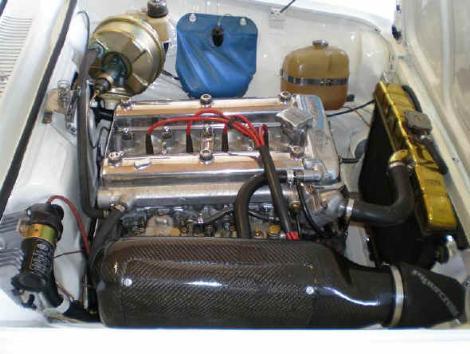| The wiring harness | The ammeter | Engine oil |
| The wipers | LED instr. light | LED Repeaters and lights |
|
If you have doubts about your oil pressure, you may check the pressure like this with a cold engine.
Oil classification
The API (American Petroleum Institute) has this system.
So, this is it. The higher the second letter, the better and more modern oil you have
The oil is very popular on TV!
The engine oil is a popular event on
the commercial TV. It's being grilled over an open fire and
then expected to be liquid after ten hours in an arctic
climate.
We sure expect the engine oil to do a
great deal in our Alfa Romeo engines.
The oil does not look as gorgeous or as attractive as your car stereo.
But it's down there in your engine, doing a marvelous job. The oil companies are developing engine oils and their additives like never before. However, one point needs to be concerned. Reduced fuel consumption is hardly the result of changing the engine oil from one make to another. It's more likely to be the driver himself who effects the miles per gallon ratio. Drive nice and you'll improve your economy.
There are five important tasks for the oil.
The first item is obvious.
Drive your Alfa gently the first minutes before you use its full potential
The second task is to clean
your engine.
Any filth and small dirt like carbon and metal particles that's being washed down from the liners by the pistons will be held by the filter. The very small particles that my pass the filter will give the oil a black color after a while. Black engine oil is no problem, it is a result of a good engine oil that is cleaning the engine and doing its job as expected.
The third task is to prevent
your engine from rust and corrosion.
Since the oil contains basic additives to neutralize the acid, all you need to do is to run your Alfa real hot for a while, like the Italian tune-up myth. See Pat Bradens Alfa owner's bible. Once the engine is real hot and the oil too, the nasty things will evaporate.
This is one of the reasons for a regular change of engine oil. I always change oil in my Alfas once a year or after 10 000 kms, which ever comes first. Don't forget to change the filter too.
The fourth task for the oil is
to cool the engine.
The temperature might reach 300
degrees Celcius there. The oil is also cooling the liners and
the bearings as well as the valves and the head. Hard work to
be done for the friend in the sump. We hardly see anything of
this working oil.
What about the oil temperature?. If you have access to a temperature gauge, you will notice that the temperature will increase at high revs. If the engine is working under pressure, say heavy load in the trunk or hill climbing, the temp will also increase. This is no problem with a good quality oil in the Alfa alloy sump. But what is the normal temperature?
First of all, the oil must not
be too cold.
To have the water and acid to evaporate, the oil must be somewhere around 100 degrees. If you drive your Alfa on a short distance without the engine being warmed up, you may find a light brown foam inside the oil cap. This is nothing to worry about, some Italian tune up will solve that problem. The temperature in your Alfa is probably around 110 to 130 degrees. If you drive it very hard, an oil cooler might be needed. See your Alfa supplier on my hot links to get one.
If your Alfa wants some oil it's OK, but if the consumption is increasing, check the head and the pistons. The job can be carried out without removing the engine.
. |
